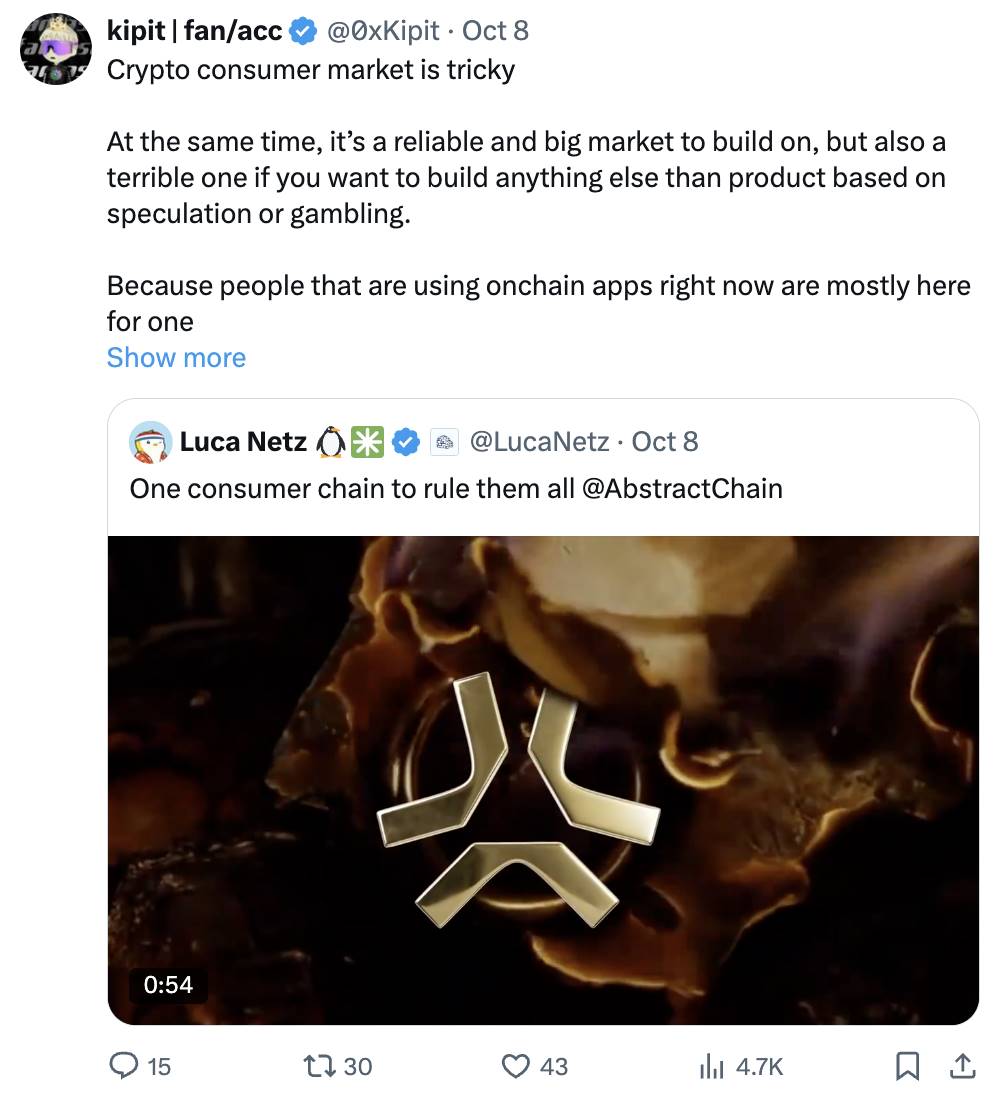Despite the rapid innovation in cryptographic technology, many products have yet to address real consumer pain points or provide genuine entertainment value.
Author: Ruthy
Compiled by: Deep Tide TechFlow

The term "consumer crypto" has recently appeared frequently in discussions, driven by some builders and thought leaders, seemingly becoming a new trend or emerging topic.
So, what does it actually mean?
Is it truly a new field, or is it a concept repackaged and gaining attention under different market conditions?
To understand the concept of consumer crypto, we need to delve into its definition, current relevance, potential growth drivers, and the obstacles it faces.
What does consumer crypto actually refer to?
Consumer crypto refers to the gradual integration of cryptocurrency into everyday consumer products, services, and behaviors. This means that people can use cryptocurrency in real life, not just for speculative trading or decentralized finance protocols.
Consumer crypto focuses on the end-user experience, integrating cryptocurrency into everyday life products such as gaming, social platforms, e-commerce, and media.
Why is this topic gaining attention now?
Is it because consumer products with huge market potential, like @Polymarket, are emerging and showing signs of widespread adoption?
Is it because blockchain intellectual property projects like @pudgypenguins are attracting global attention?
Is it because people, especially the younger generation, are increasingly disillusioned with traditional financial systems?
Is it because blockchain technology and applications have matured, and user experience has become the focus?
It could be a combination of these factors.
Looking ahead to 2025, we may see more products emerging from the Web3 space and entering the global market, with venture capital firms also moving in this direction, investing in user experience solutions, such as the $14 million funding received by @initiaFDN and the $65 million funding received by @infinex_app.
With some companies recently announcing the integration of cryptocurrency into their products, it is clear that we are moving towards a world where cryptocurrency will become mainstream, ushering in a new breakthrough moment.
PayPal announced its crypto services for business accounts.
Visa is collaborating with Transak to facilitate cryptocurrency to fiat transactions.
I personally even ordered a card from @biptapofficial to test this direct crypto to fiat payment model. This will make life more convenient.
What obstacles do we face?
Incentives and Target Audience
Many teams claim to be at the forefront of consumer crypto, developing applications for the global market. However, they often focus too much on attracting initial users to Web3 and design incentive mechanisms around speculation and profit. They view this approach as part of achieving product-market fit and user onboarding.
But what would happen if these incentives were removed?

Fragmentation and Friction
Different blockchains and platforms often operate independently, causing friction. For users, fragmentation means facing multiple interfaces, wallets, and token standards, increasing complexity. With assets distributed across different platforms, liquidity is fragmented, and efficiency is reduced.
This fragmentation has led to the development of dedicated chains like @AbstractChain and @RoninNetwork, which build vertically integrated ecosystems. Meanwhile, @infinexapp has created a horizontally integrated platform similar to a decentralized exchange by integrating cross-chain user experiences and positioning itself as a user experience layer.
In discussions with team members, I found that Abstract's vision bears a striking resemblance to the achievements of applications like WeChat or KakaoTalk.
Our (Abstract) team is committed to creating the preferred destination on-chain, designed to be the most interesting place on the internet—I call it the "crypto digital amusement park" or the "Disneyland of the internet." The image below showcases our determination to provide an uninterrupted, excellent user experience. Over time, we hope to attract users by introducing new products, ultimately evolving into a universal chain.
WeChat started as a messaging app in China and has now evolved into a massive ecosystem encompassing social media, payments, shopping, news, and mini-programs.
Abstract can also be seen as a similar ecosystem application, starting from an initial use case and expanding horizontally after establishing a strong vertical integration foundation.
Perhaps this is the development path for dedicated chains like @abstractchain and @Lucanetz?
Product-market fit remains a major challenge. Despite the rapid innovation in cryptographic technology, many products have yet to address real consumer pain points or provide genuine entertainment value.
To date, we have seen a few Web3 products like Polymarket and Axie Infinity enter the mainstream, but these are isolated cases. To make consumer crypto products widespread, we need more products that can solve real problems or provide meaningful entertainment value. This means developing interesting games that do not solely rely on "play-to-earn" mechanisms or creating financial products that genuinely improve lives, rather than just attracting speculators.
What do you think adoption means?
The adoption of consumer crypto involves different stakeholders, each with varying incentives, especially between builders and traders. While both can benefit, their motivations and approaches are vastly different.
Builders are responsible for developing the infrastructure, applications, and ecosystems that promote the adoption of cryptocurrency. Their goals extend beyond short-term price fluctuations; they focus on providing value to users, generating revenue through transactions, and attracting investment through product-market fit.
Traders, on the other hand, view adoption from a different perspective. For them, adoption means increased liquidity and more opportunities for profitable exits.
What are your thoughts? Feel free to share your ideas.
免责声明:本文章仅代表作者个人观点,不代表本平台的立场和观点。本文章仅供信息分享,不构成对任何人的任何投资建议。用户与作者之间的任何争议,与本平台无关。如网页中刊载的文章或图片涉及侵权,请提供相关的权利证明和身份证明发送邮件到support@aicoin.com,本平台相关工作人员将会进行核查。




